Sinfest is most probably a comic everyone has heard of – Tatsuya “Tats” Ishida’s daily strip has been going strong for some thirteen years now but things have recently taken a surprising feminist turn.
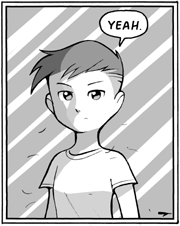
Main characters Slick and Monique have evolved a lot over the years as the former has had his panel time reduced and his social consciousness slightly raised, while Nique has gone from being the irritated sex-object of Slick’s affections, to an opinionated cropped-hair feminist who questions gender norms.
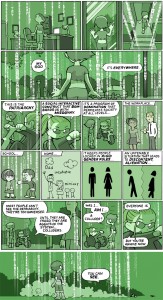
Originally the comic was indeed a Sin-fest, stuffed with black comedy and poking outrage for humour, but it has changed slowly but surely over a period of time. The most recent change, that of addressing the patriarchy and portraying its hold on society as akin to the Matrix, is by far the most subversive. Not only is the comic addressing themes that many other webcomics are failing on, but it is doing so with an already large fanbase attached to the comic for very different reasons. Forums and message boards are overflowing with former “fans” berating Tats for being a misandry-lover or brainwashed by feminism.
While the comic had formerly poked fun at all ideologies and religions (similar perhaps to South Park albeit slightly softer as years went by), fans who expected feminism and talk of “mansplaining”, “hetereonormative assumptions”, gender performativity” and so forth to be a lead into an epic put down of a so-called feminist agenda, were very mistaken. Tats, aware of how his comic had previously played into patriarchal norms and reinforced institutional sexism was now clearly changing his mind and turning the lens squarely on himself and his own paper universe.
Nique, the glamorous and fun girl who loved to shake her booty at guys for a reaction was shown the Matrix of Patriarchy and allowed to voice her thought patterns and come to her own conclusions. In an act of defiance she close-crops her hair and rejects what society says she should look like. In this one strong act, one character known for her very feminine look defies the male gaze upon her. Not to say that femininity is bad – of course it is not. But in the world of comics where a huge majority of women look very much alike, and in our world of celebrity culture where the same is encouraged and the different seen as troubled, it was a hugely important move. And a brave one (albeit for a male creator) due to the dedicated audience base of the comic, with its vocal male membership.
The same audience reacted just as Tats predicted in Nique’s own journey – horror, rejection, accusations of brain-washing, and complete entitlement. How could he ruin their beautiful female character who wiggled her butt and teased the men? Ruin equaling, of course, the cutting of her hair that for Nique signaled the ownership of her own agency.
There are a great number of women created webcomics that are exploring similar themes – The Adventures of Gyno-Star and I Was Kidnapped by Lesbian Pirates from Outer Space are two of my favourites – and they are sadly overlooked. Sinfest already had a huge internet presence and the creator could have easily continued on his same path for many years with great success. Instead Sinfest became one of the few big webcomics to not only address feminism and sexism in our society, but to do so honestly and intelligently.
Tats, known for being so unknown in real life, ignored the haters and has continued on this new path. Sinfest still features daftness and heart-warming strips, political satire and amazing adventures starring the whole cast of wonderful characters, but it now does so in a way that is about both entertainment and education, as well as being a very welcome sight for those of us beaten down by sexism elsewhere online.
Other characters have evolved too – especially Seymour starting to realise how much he has conflated his fanboyish worship of Jesus with his fundamentalist religious beliefs, and Li’l E losing his memory and making new friends, with his backstory being fleshed out a little in heartbreaking fashion.
Sinfest has always been a fun and entertaining strip, but now I heartily recommend it to each and every reader I meet. Sinfest Volume 1 is available from Dark Horse (and contains the pre-2000 non-web strips), as is Sinfest: Viva La Resistance, and there were three self-published volumes at one point too. And as with all webcomics, the entire series can be read for free at the website – so indulge yourself today!
(NB – Sinfest also appears in the Nemi magazine in Norway, which is named after the most popular strip – Lise Myhre’s Nemi. Which is also the best comic strip in the world and frustratingly only 4 volumes have been translated into English – argh!!)
Laura Sneddon is a comics journalist and academic, writing for the mainstream UK press with a particular focus on women and feminism in comics. Currently working on a PhD, do not offend her chair leg of truth; it is wise and terrible. Her writing is indexed at comicbookgrrrl.com and procrastinated upon via @thalestral on Twitter.


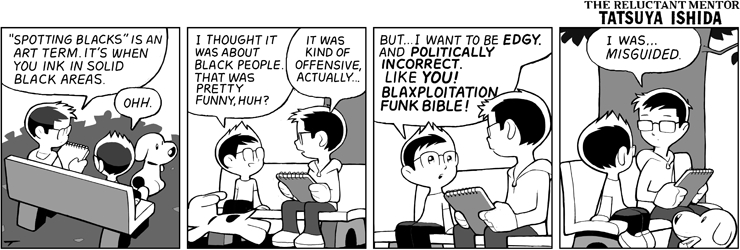
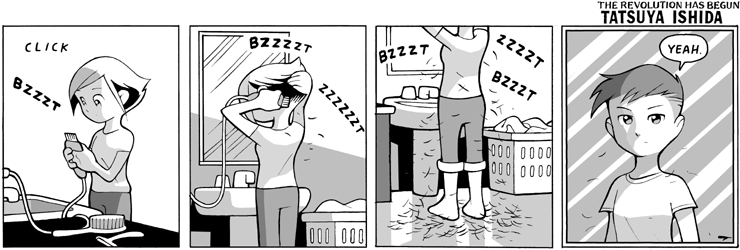
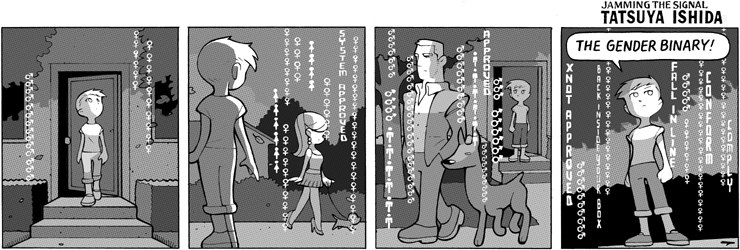
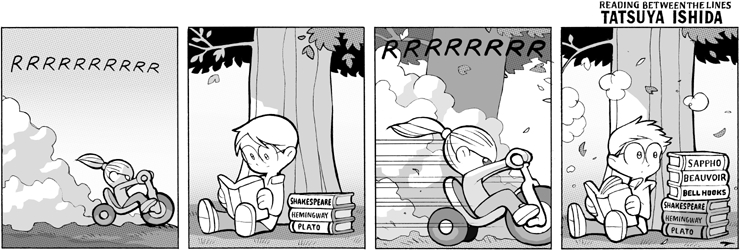
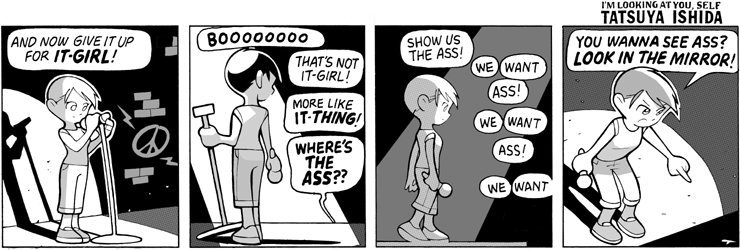

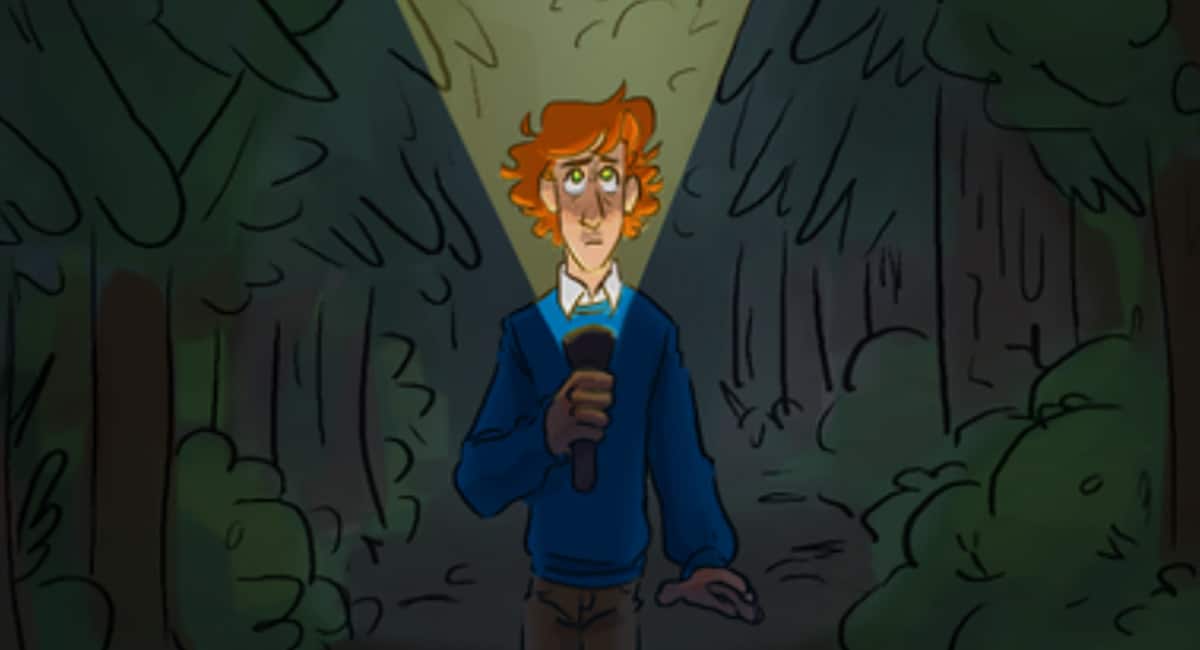

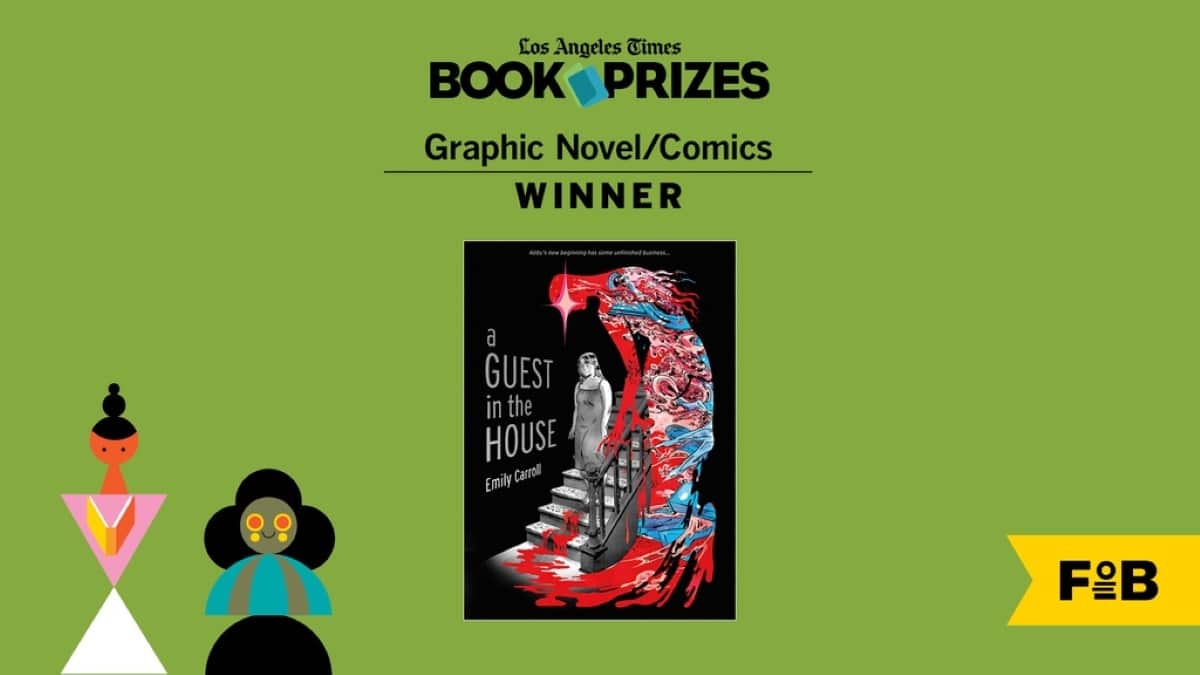

I’ve been a Sinfest reader for a long time. I’m enjoying the latest storylines, personally. The best stories in SF have always been the ones that were about something serious, and I like how he’s handled the feminism plots, too.
I’ve followed this strip from its early days. As of late, I’ve felt my taste for it dissipating. I support feminism, as long as it isn’t the extremist ‘kill all men’ sentiment, but the comic focuses on it so much that it has become unenjoyable. I loved the characters and wanted to see development- and, for a while, they had it- but now, it’s all been pushed aside to repeat straw man arguments and reaffirm the horrors of misogyny. The message is a good one, but I feel like it’s come at a cost to the webcomic. Like Slick, I feel like the old Sinfest is a friend who has changed, and that I miss the old friend. I understand and relate to the comic where Slick is claiming that he ‘wants the old nique back’, and turns out to be just saying “Me, me, my needs, all about me-” but I can’t ignore my personal comfort levels for something I use as entertainment, especially when one of my favorite characters is repeatedly thrown back into the depths of the shallow end in order to repeatedly prove a point.
What sinfest excelled at in the past was mocking institutions (be they corporations, churches, governments) with wry humour and poignant observation.
But the last couple of years have almost totally lost the plot. 90% of Sinfest these days just isn’t funny. Beloved characters who used to have depth (no mean feat, when you consider their depth was developed in such a short form medium) have been reduced to 1 dimensional stereotypes, and where thoughtful, provocative wit once flourished, now there is only a dreary daily repetition of the same cardboard cutout portrayal of a man-hating form of feminism.
In the past the comic has dealt with various social issues but it never lingered too long on them, without changing topic for a while or giving you a comic interlude and then returning. This is really important; people don’t like being preached at. If you want to get people to think differently about issues, you need to coax them into making the cognitive leap by themselves, not beat them over the head.
The approach at the moment is not really advancing feminism; the comics are so dry now, and so relentless in their preaching tone that the only people who still enjoy them are the people already subscribed to the type of feminism the strip espouses. Tats is preaching to the choir, not gaining converts.
Respectfully I completely disagree. The Sinfest forums are bustling and not just with new readers but old ones who are enjoying the new strips as well. I’ve posted Sinfest on my facebook and it is being enjoyed not only by those “converted” to feminism but just about everyone.
It is still funny, the characters are still three dimensional, and it certainly isn’t “man-hating” though I see that complaint a lot from ex-readers who dislike the focus on women and feminist issues. But not from the huge influx of new readers.
I’m relieved that Tats has not felt constrained by the old and has embraced the new, the strip is a lot better for it.
“It is still funny, the characters are still three dimensional, and it certainly isn’t “man-hating” ”
Not really. Jokes have decreased substantially, more than half the comics are only “men are the evulz!”. I hardly laugh anymore since every strip I see is “the feminist posse does something that defies the patriarchy” with no punchline. Just take, to mention an example, the recent “Jessica Christ” arc. God showing Adam and Eve? How does he dare! An heterosexual couple with a man! But then when he shows “Madame and Eve” then it’s suddenly the rightest thing ever. Then it goes to show how Jesus being a man is bad for people to think- it should have been a woman, because only them can set things right. And all the strips are just like that, beating the same dead horse. Men can’t appear without being the personification of evil. Except maybe the gay guy, because gays must be something along the lines of “women in the body of a guy” and so they get a pardon.
The characters aren’t three dimensional at all. Feminist posse is just that, feminazism incarnate (because let’s face it, when you shove your point of view down people’s throats it isn’t just plain feminism anymore). Slick, Devil and Sam are “generic male representation that offends women just existing and proves that the feminazis are right”. Nique and Tatsuya himself are “feminism (feminazism) is the true light of salvation, we all should turn to it and be saved”. The rest of the characters follow similar lines, save Lil’E who seems to be. for the moment, outside of the feminism plot. That is, the rare times he appears.
The man-hating point, I don’t really get how you miss it. Let’s take for example a strip from not so long ago (sorry that I don’t remember the exact number) where the gay guy ogles the demon bouncer. As I said before, he seems to get a pardon from being an asshole and we’re supposed to find funny that he likes the bouncer. But we’ve seen before many strips were Slick does the same to a girl and he’s shown as doing the wrong thing. What? How about the SCUM manifesto they give the demon girl in Fuchsia’s place? Or are you saying that “Society for Cutting Up Men” isn’t a man hating title? A book that says that men are incomplete women that should be wiped out the face of Earth, nothing less.
Among many other things, but I’m getting tired of writing.
Oh, yeah, one last thing: notice how the “patriarchy” is all the devil’s fault (because, of course, anything men related must be the work of Satan himself) and how girls are never shown to do anything wrong since all this started (even devil girls get portrayed as misguided or forced to do what they do). Good thing we have Xanthe and her groupies to liberate the world from the evil clutches of men while looking badass every time and not a total jerk with a “holier than thou” attitude that would put Seymour’s one to shame.
Another problem with the new direction is the consistent message that heterosexual sexual attraction is oppressive and inherently evil. Homosexual attraction and even aggressiveness are acceptable (that isn’t hyperbole…there are numerous strips showing women and men engaging in straightforward sexualized contact in a positive light), but even Charlie Brown’s innocent infatuation with the little red headed girl is marked as criminal (he is given a restraining order). In Ishida’s world, the only acceptable male-female relationship is not only platonic, but entirely absent of sexual desire.
This isn’t even radfem. This is a bizarro ultraradfem powered by a weird, inhuman, self-righteous disgust of hetero male sexuality. According to Ishida, it is not possible for hetero men (i.e. “dudebros”) to be sexually attracted to a woman while also being respectful, admiring, and loving. And it is not possible for a hetero woman to be sexually attracted (or make herself sexually available) without being either a culturally programmed robot or a tool of Satan. In short, hetero sex = evil.
And this makes for a humorless, off-putting comic. But the art is great.
I think you explained the story and direction of Sinfest quite well, but I’m another fan who has been disappointed of the direction. I was EXTREMELY interested in the beginning when he decided to have Monique start down the road she’s been going (and I’m a guy). However, as time continues, it seems that the road was a dead end, as I don’t see any real new development for Monique.
I enjoyed both the seriousness and lightheartedness of the webcomic as a whole. A considerable bulk of the latest comics have been focused on pro-feminism, and (for me) it is dragging the comic down. When one storyline (with only one message) is constantly being reiterated, it offers less time and progress for the other storylines to continue.
I’m all for women’s rights and his message towards stopping the sexualizing and degrading, but can we move through that message to some new (or at least additional) observations?
For the author of this site: You are clearly an advocate for the direction Sinfest has taken. What path/story can Monique take from here?
I see a very short road, if not a dead end.
Feminism hasn´t being subversive since the 80´s.
This is just one-sided, simplistic, emotionaly and mentaly unbalanced raw doubt, splashed on the faces of people ho realy think life is as simple as “bad people make you be what you are, and they are meanies for doing so”.
There has been no Soul-Searching, no Acceptance, no Growth. No real expansion of mind and/or consciousiness. There has being only mindless and pointless angst against half of humanity, that happens to have a penis.
In fact, Sinfest has deprived itself (even in the matter of drawings, scenarios and plots) of Diversity. It is now only a repetition of the same Themes, the same Universe, and all of the Comic whas enclousured in it, as if it where now only a mutilated version of itself.
And that is not subversive. That is average-woman-scape-pod-of-everiday-reality (the same way sports are average-man-scape-pod). In fact, there are SO many socially ajusted, moraly respected and socialy recognized people who are feminist, and would not be, being them not feminists, you could even say it is a way of Social Ascension and Status Quo mantenance.
Subversive are those things that bring turmoil and awe to society. Those things that open new paths of life, and bring REAL change. Things that also bring fear to large amounts of people. Things that make the the average person gasps and say “good god, someone stop this lunatics!”. Not some pity cat-fight against other peoples opinion over your life style.
Subversion is something that most people fear. Specially Americans. And if you are a average-middle-class-person, and specially a average-middle-class-american, and aren´t afraid of it, them i might say – it probably isn´t subversive.
Why does it seem that in order to post a dissenting comment towards anything involving feminism, people must first extoll that they are for it? Why can’t different perceptions be taken as that without instinctively being seen as someone who is anti?
That aside, I am also upset with the ongoing theme and I concur with the whole beating a dead horse take. There are injustices and they are wrong; but why does every man seem to embody them if they aren’t sisterhood affiliated? Even Criminy was seen as something other than respectful by Monique when he told her he was reading feminist literature (for educational purposes), but was clueless to the matrix like code of the patriarchy that she sees?
Is not educating yourself on something the right path to take on correcting issues? Why does someone have to see and understand exactly the way you do in order to be respectable?
Let’s see… as said elsewhere already it’s dead. Brain dead.
Art & style: manga, lots of concepts stolen from Schultz & Watterson -> Always remember: “hommage” ONLY if done properly! Understanding the artists is more important than copying them in the first place.
Before: pseudo-liberal attitude, sometimes philosophic, actually not that much depth -> Ishida was just lazy and afraid to articulate his thoughts and beliefs openly. Lots of eye rolling going on once you see his personal opinion shine through in some of the strips.
Now: feminazism as a permanent replacement for proper arguments, characters and storylines -> Replacing male with female chauvinism is most certainly NOT helping the emancipation of women! Making fun of gays and using racist stereotypes for political issues (e.g. during the election 2008) doesn’t help much either.
Conclusion: As I said in the beginning, it’s dead. RIP.
I have just finished a marathon archive binge of this – as it is now only fair to call it – comic saga. Exhausting even for an utter introvert … I think I will definitely be a follower, though.
I am glad to see it defended in its later incarnation. It must certainly have been a very risky development, but kudos must be given to the author for using his platform to take that conscientious but never-popular stand as a male ally of radical feminism. The easier course in some ways might have been to start a new comic to specifically embody those views, but that would have had to build its audience from scratch. Risking his existing fanbase in a principled stand is certainly a gesture one must respect, and Tat repeatedly acknowledges the sense of moral duty he feels for having built that fanbase up by dubious means, such as the politically incorrect, sometimes crass humour of his earlier strips. Indeed, although some of them were many years ago, even with hindsight I do find a lot of them much harder reading than the oft-reviled radfem strips. The thankfully-retired “Politically Incorrect Fringe Power Rangers” jokes that used to be regular filler are a level of cringeworthy now thankfully absent for years – I would sooner have any number of author-avatar mea culpa strips.
Looking back, though, the only serious weakness of the Sisterhood saga may perhaps be that it had to develop out of such strips: especially the dated satire of the very early “Matriarchy” strips (a Two Ronnies-esque depiction of a “feminist” dystopia) and Xanthe’s initial one-off strip (2007-02-09 to 2007-02-10, in which she and a Sisterhood colleague “sissify” Seymour with make-up – not something one can imagine them doing anymore, thank goodness). Though Xanthe has become a more charismatic character in time, the fact that she initially had to develop out of this quirky and embarrassing one-off character did not give her the most auspicious start. Still, even if one assumes the Sisterhood saga to be a massive apology for having misrepresented feminism in the past, it is certainly a spectacular one.
In terms of character development, the shift away from joke-a-day to greater continuity has been very helpful. Blue and Fuchsia, once just presented as randomly violent and lustful succubi, now have total motivation, since it has become apparent that the only “empowerment” for women in Sinfest city is to become full minions of “Mr. D” and thus get to pay back their oppressors as agents of punishment. Slick was always a contemptible human being with occasional bright spots, but the shift towards a darker mood in general has at least forced him to finally start asking hard questions. Monique has really come into her own since getting her distance from him, and her romance with Absinthe is no less than she has deserved after 12-odd years of putting up with Slick. The Fembot story arcs have been heartbreaking, especially the one killed in a pathetic act of state-sanctioned domestic violence (when its owner, aware that he is regarded as a loser for buying it, batters it to death even as it is trying to be supportive).
In a sense, the comic has barely shifted its politics – Slick’s ridiculous “pimp daddy” ideal was always seen as something inherently awful, from the very first, soul-selling strip – but in acknowledging that the subject matter is not, in fact, all that funny, Tat has injected a great sense of purpose and urgency. The whole mood, both within the world of the comic and in the sense of what it aims to achieve, is now one of “joke’s over, let’s get real about this and do something while we have time.”
My one regret is that the prominence of the Sisterhood arc has really pushed the adorable Fuchsia / Criminy romance into the background, but that really had to happen. They were, in their way, the prototype for the new style: a mini-saga that added a level of tension and emotion that the cynical, joke-a-day world of Sinfest had previously lacked. The fact that the return of the Sisterhood proved the catalyst for finally getting them together (2011-10-20) seems strangely fitting.
Comments are closed.